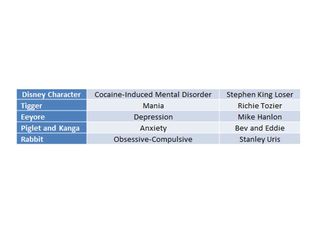
OCD
Disney Plus Dream Job: Winnie the Pooh
Viewing Winnie the Pooh through a psychiatrist's lens.
Posted December 8, 2019
Introduction
Faculty, residents, and students at my university are participating in the Disney Plus Dream Job to watch 30 Disney films in 30 days. Course directors successfully incorporated the 30 films (and shows) into our preexisting curriculum that teaches psychiatry to future physicians through film and other aspects of popular culture. Views Through the Psychiatrist’s Lens will publish daily blogs throughout the 30-day Disney Plus Dream Job. Our tenth blog is on the 2011 film, Winnie the Pooh.
Synopsis
Winnie the Pooh is a 2011 animated musical comedy produced by Walt Disney Animation Studios inspired by A. A. Milne’s stories of the same name. The eponymous character is based on a teddy bear owned by Milne’s son, Christopher Robin Milne, and their relationship is perhaps best dramatized in the film Goodbye Christopher Robin (2017).
At the time of this posting, the film holds a rating of 7.2 out of 10 on IMDb and a tomatometer rating of 91% on Rotten Tomatoes.
How it relates to the field of psychiatry
As the teaser image clearly demonstrates, Winnie the Pooh draws an eerie comparison to Stephen King’s It.
In this blog, we'll look at Disney’s "losers club” a bit closer in the context of Cocaine-Induced Mental Disorders. The DSM-5 lists four mental disorders that can be induced by cocaine: a) mania, b) depression, c) anxiety, and d) obsessive-compulsive disorder (which the American Psychiatric Association separated from the other anxiety disorders in 2013). Interestingly, several of AA Milne’s characters in the Hundred Acre Wood depict signs consistent with the above mental disorders (Table 1). There is no discrete evidence that cocaine is used in either Milne’s or King’s books or films. Instead, their respective works introduce characters (e.g. Tigger) that depict symptoms (e.g. flight of ideas) that are consistent with mental disorders (e.g. Bipolar Affective Disorder). What’s interesting is that cocaine may induce each of the mental disorders manifested in Winnie the Pooh and It. Now, we’ll take a brief look at a few of these relationships.

Tigger and Richie Tozier
We are introduced to Tigger at the beginning of the film through his agitato song ‘The Wonderful Thing About Tiggers’ with the ending line, “…I’m the only 1!” Not only does the song exemplify Tigger’s flight of ideas, activity being increased, and talkativeness, but his final line reminds clinicians that epidemiological studies suggest a lifetime prevalence of bipolar type I in the general population to be about 1% (1).
Richie Tozier is a character in Stephen King’s "Losers Club” who “realized…that a lot of the problem had been his own mind, which was usually moving at a speed 10 or 20 times that of his classmates" (2). The description of Richie’s behavior in King’s novel is consistent with Richie having been afflicted with Bipolar Affective Disorder as a teenager. For more details about Richie’s case history, click here.
Rabbit and Stanley Uris
Rabbit is obsessed with keeping everything organized. This is often portrayed when he is gardening. While the need to keep everything perfect and in order is defining of Obsessive Compulsive Personality Disorder (OCPD is a personality disorder), Rabbit’s obsessive thoughts may warrant independent clinical attention. If we believe his intrusive thoughts impair his functioning, then Obsessive Compulsive Disorder (OCD is an anxiety disorder) should be investigated. Before we could rule-in OCD however, clinicians would need to ensure Rabbit’s symptoms are not better accounted for by the direct physiological effects of a substance such as cocaine.
In the Stephen King novel, an adult Bill Denbrough recalls words once spoken by Stanley Uris, “I could stand to be scared, but I hate to be dirty” (2). Similar to Rabbit, Stanley’s comment is consistent with OCPD thus prompting the clinician to again consider the role of cocaine in the pathogenesis and perpetuation (It: Chapter 2) of Stanley’s intrusive thoughts.
With five characters accounted for, which Disney inhabitants of the 100 Acre Wood match up with Bill Denbrough and Ben Hanscom? Bill and the portly Ben fill out the love triangle with Beverly (Bev) Marsh. Bill’s intelligence and leadership qualities are juxtaposed to Ben’s being good natured and, well, jolly. Those qualities are captured by Owl and Winnie, respectively. While the latter two Disney characters do not personify traits of a Cocaine-Induced Mental Disorder like the other five (Table 1), they may play a role in biopsychosocial treatment planning for individuals afflicted with substance use disorders. For example, Owl’s incessant planning and letter reversal indicate a role in the manufacturing of cocaine while Winnie’s constant search for “honey” depicts him as the perfect “middleman.”
References
Rowland, T. A., & Marwaha, S. (2018). Epidemiology and risk factors for bipolar disorder. Therapeutic advances in psychopharmacology, 8(9), 251–269.
Barns and Noble (2018). IT: a novel.

